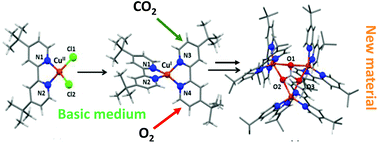A new tri-nuclear Cu-carbonate cluster utilizing CO2 as a C1-building block – reactive intermediates, a probable mechanism, and EPR and magnetic studies†
Abstract
This work demonstrates that simple copper-bipyridine compounds and atmospheric CO2 react to produce useful/complex materials under appropriate conditions. Starting from a distorted square planar copper(II) complex, [(tbubpy)CuCl2](tbubpy = 4-tert-butyl-2-(4-tert-butylpyridin-2-yl)pyridine), an air-sensitive, copper(I) complex, [(tbubpy)2CuI][BF4], which exhibits a distorted tetrahedral geometry, was synthesized and characterized. Reactions of [(tbubpy)2CuI][BF4] with CO2 inside a sealed tube and with air were carried out over a week and three weeks, respectively. A new tricopper(II)-carbonato cluster, [{(tbubpy)2Cu}3(μ-CO3)][PF6]4, was isolated with three distorted octahedral copper(II) centres bound by a carbonate-bridge formed from atmospheric CO2. NMR and UV-Vis spectroscopic analyses coupled with previous reports point to a multi-step process in the formation of a trinuclear CuII-carbonato cluster that includes the probable involvement of μ-hydroxo-bridged dicopper(II) type intermediates.



 Please wait while we load your content...
Please wait while we load your content...